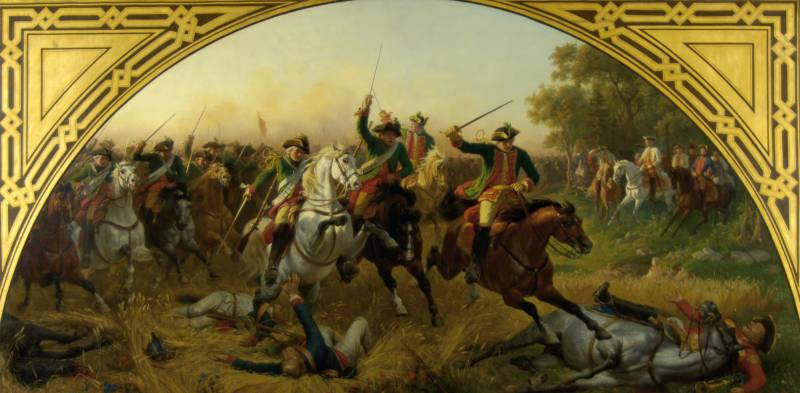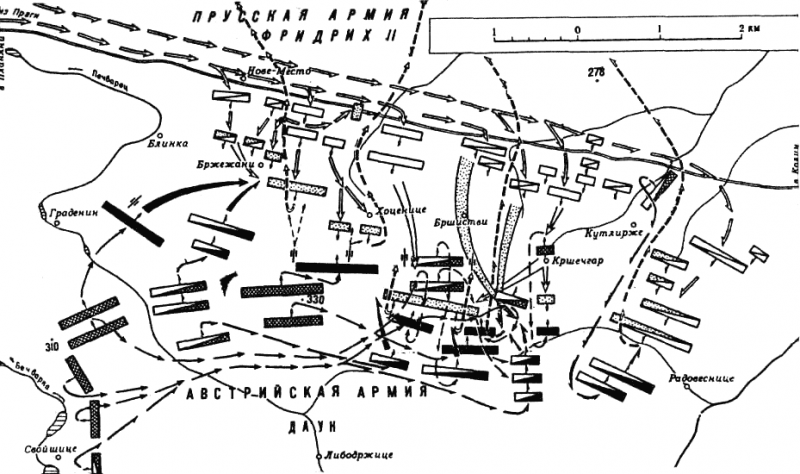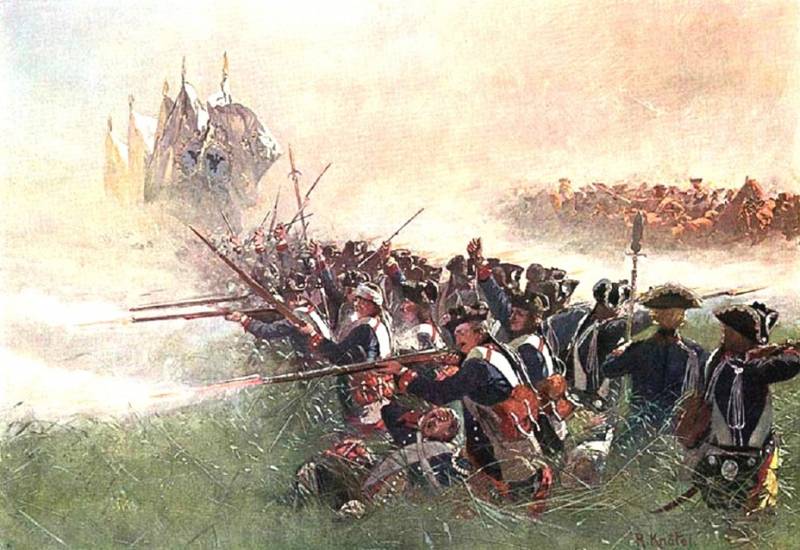“Dogs, and after that you still want to live forever?”. How Frederick the Great suffered his first defeat

Carl von Blaas "Battle of Kolin, 1757"
There was a Seven Years' War (1756-1763). Frederick II, having defeated the army of Saxony and occupied it, now decided to strike a decisive blow at Austria and withdraw from the war. And after all, everything went like clockwork, but that was until he suffered a crushing defeat at the Battle of Kolin, after which the Prussian king began to have large-scale problems.
After the defeat of Saxony, Frederick the Great decided to strike at Vienna - the capital of one of his enemies - Austria. But it was still necessary to get to Vienna, and by the shortest route, until France and Russia entered the war on the side of Austria - otherwise it would not seem enough, because many people looked at the Prussian king with discontent: France, Austria, Russia, Sweden and a number of small German principalities. And the shortest route lay through the Kingdom of Bohemia, which belonged to the Habsburgs, which is why Frederick the Great sent his troops there.
So, at the beginning of 1757, Frederick II invaded Bohemia with an army of 60 men. To meet him came the army of the beloved brother-in-law of Empress Maria Theresa, the stadtholder of the Austrian Netherlands, Charles-Alexander of Lorraine, numbering 000 people. But Karl-Alexander was defeated and was blocked by the Prussian king in Prague. It seemed a little more, and Prague would capitulate, especially by the end of June, food supplies were to run out. But it didn't happen.
Meanwhile, in Austria, a new army was assembled to help Prague, and it was led by the talented (despite his unpromising surname) General Leopold Joseph von Daun. The number of this army is 54 people. And then Frederick sent a corps of 000 of the Duke of Bevern to meet Down for reconnaissance. However, Frederick the Great nevertheless decided, taking with him another part of the troops (most of them remained near Prague), to go to the aid of the Duke of Bevernsky. Firstly, in the event of a collision between Down and the Duke, the ratio of forces is 18: 000 (Prussians: Austrians), that is, the guaranteed defeat of the Prussians in this case is ensured. And secondly, it was inconvenient for him to besiege Prague and guard communications at the same time, especially when there was a large enemy army nearby.
On June 14, Frederick II joined up with the Duke of Bevern. In general, initially he wanted to drive Down out of Bohemia, but only the Austrian took a rather fortified position and did not intend to leave from there, so the Prussian king decided to attack him. And the enemies met near Kolin, a small town on the Labe River. Daun took quite a good position for himself: both flanks are located on heights, the left plus is protected from coverage by a chain of lakes; the center is between the heights and in deep echelon, and there is a significant force of cavalry on it, so the Prussians cannot use a frontal attack.
The enemy forces looked like this: 35 infantry and 19 cavalry at Daun, including 154 guns, and 21 infantry and 14 cavalry at Frederick II, including 90 guns.

Scheme of the Battle of Colin June 18, 1757. It shows the Prussians with white arrows, the Austrians with black arrows.
So the battle began around noon on June 18th. Frederick II decided to use a "oblique attack" - that is, to strike the main blow on the right flank, and on the center and left flank - an auxiliary blow, but Count Down guessed his plan, and therefore the right flank was further strengthened. But the Prussian infantry was still able to wedge into the right flank, but the Prussians were stopped in the center, and by 16:00 they were thrown back on the left flank. As a result, the Prussians, who broke through on the right flank, are surrounded: they are attacked in the flank and in the rear. Frederick II decided to help the encircled and sent his cavalry to attack the center. But the attack was repulsed, and in turn, at about 18:00, Daun carried out his own, more massive cavalry attack, and then the Prussians fled.
Covering the retreat, the cuirassiers of the famous cavalryman Count von Seydlitz, who was promoted from colonel to major general, and the 1st Life Guards battalion of General Tautsinen distinguished themselves.

Richard Knetel "Prussian Foot Guards at the Battle of Kolin in the Seven Years' War"
As a result of the battle, which lasted about 6 hours, Frederick II was completely defeated. He had to, dividing his forces into two armies, one of which covers Saxony, the other - Silesia, leave Bohemia. The losses of Prussia were almost 5000 more than Austria (Prussia - 13 people, 768 guns, 45 banners; Austria - about 22 people). The myth of the invincibility of Frederick the Great was dispelled; it was from the annoyance that he had ceased to be invincible that the king exclaimed in rage those words that are in the title of the article:
However, it is rather historical joke, but maybe true...
In honor of the victory, Maria Theresa established an order named after her - the Order of Maria Theresa, and the first person awarded this order was the winner himself, Count Leopold Joseph von Daun.
Information